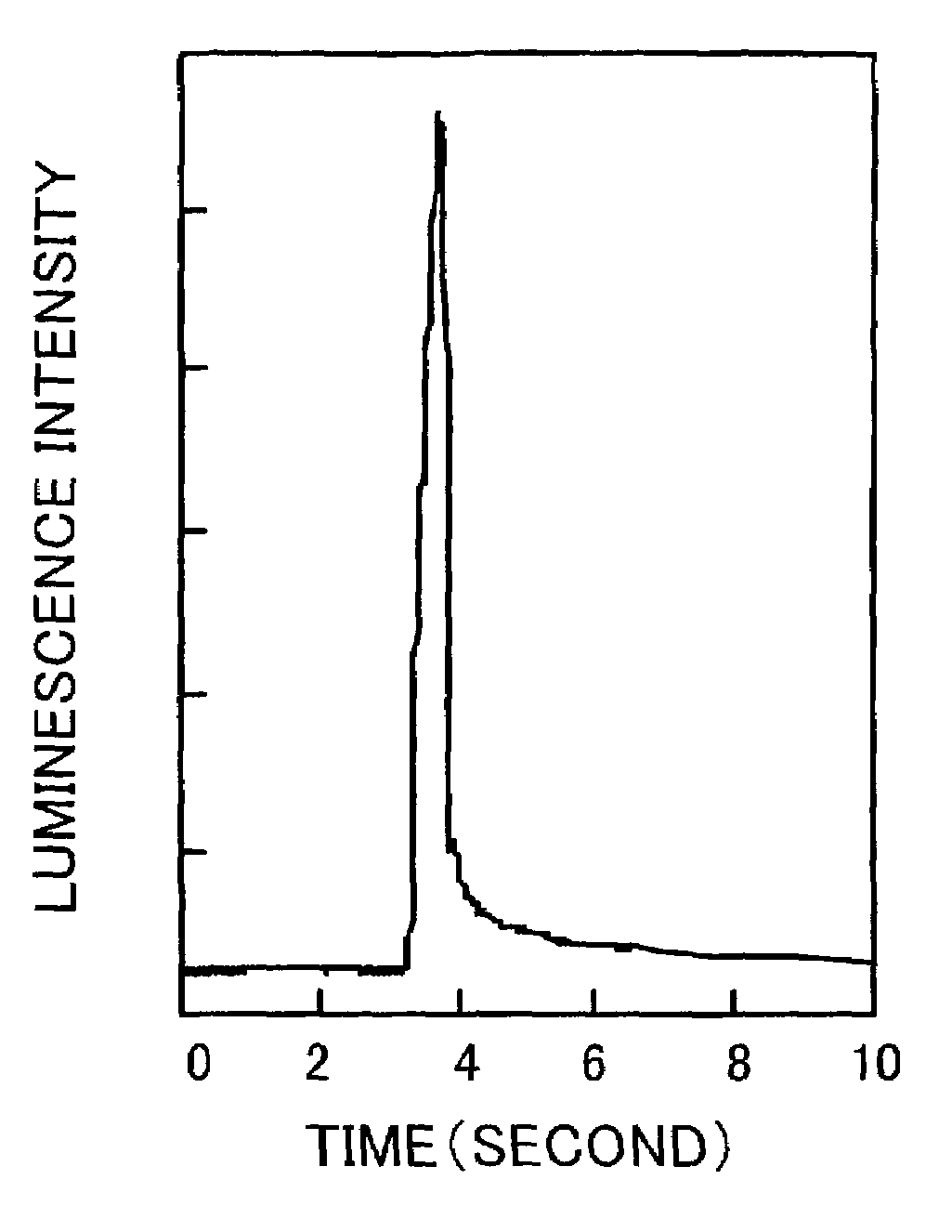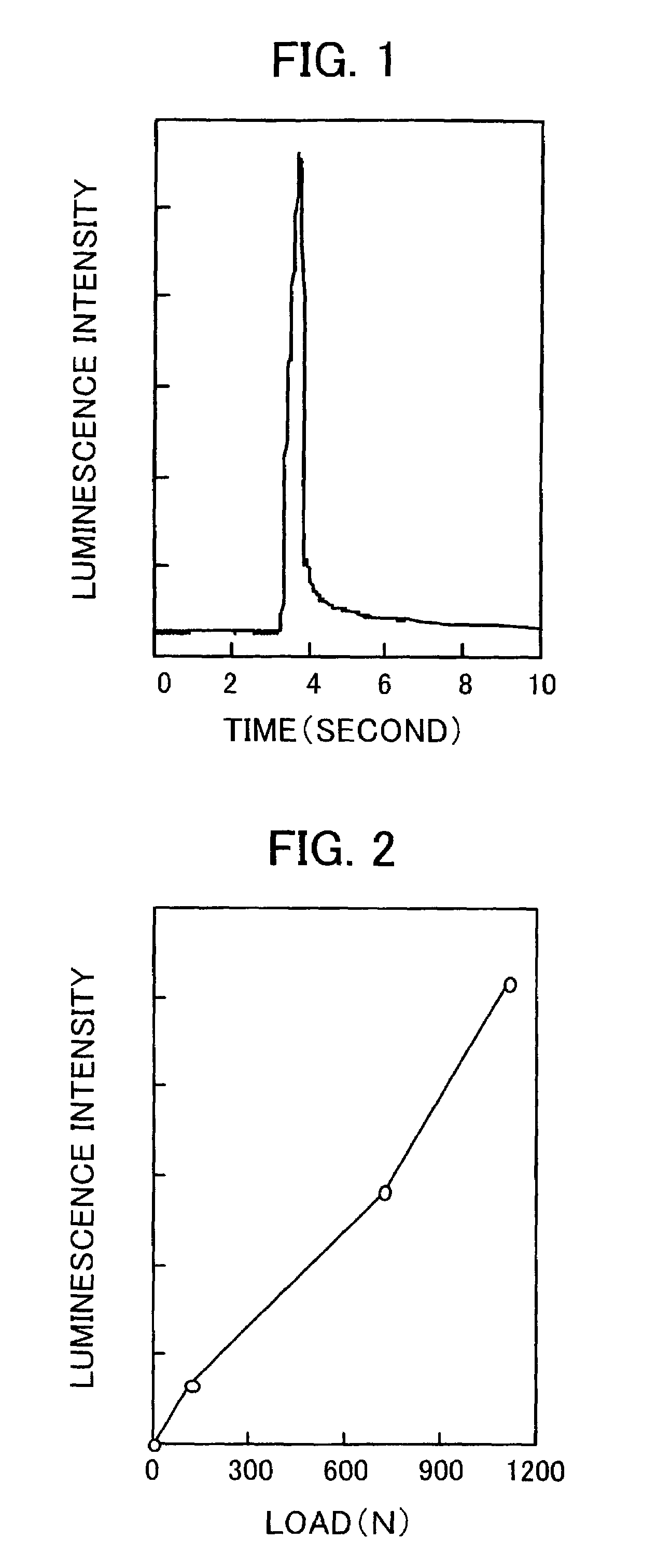Mechanoluminescence material, producing method thereof, and usage thereof
a technology of mechanoluminescence and material, applied in the field of mechanoluminescence material, can solve the problems of insufficient luminous intensity of light-emitting materials, and cannot be put into practical us
- Summary
- Abstract
- Description
- Claims
- Application Information
AI Technical Summary
Benefits of technology
Problems solved by technology
Method used
Image
Examples
example 1
[0093]Sr2Al2SiO7 in the form of powder was used as the mother body material, and Eu2O3 which functioned as the luminescence center was added to the mother body material so that an amount of Eu2O3 was 0.05 mass % with respect to the mother body material. Further, boric acid which functioned as a flux was added to and mixed with the mother body material so that an amount of the boric acid was 10 mass % with respect to the resultant. The mixture was sintered at 1300° C. for four hours in an argon atmosphere containing 2.5 mass % hydrogen, so as to prepare a sintered compact of the mechanoluminescence material.
[0094]Next, the sintered compact that had been obtained was crushed into powder. 20 mass parts of the powder were put into 100 mass parts epoxy resin (trade name: Specifics-40, made by Struers Co., Ltd.) so as to prepare a sample in the form of pellet (hereinbelow, referred to as pellet sample).
[0095]A mechanical force of 1000N was applied, using a vise, to the pellet sample (Sr2A...
example 2
[0097]The pellet samples of the mechanoluminescence material having the mother body material and the luminescence center shown in Table 1 was prepared in the same manner as in Example 1, and the luminescence intensity (cps) of each pellet sample was measured. Table 1 shows results of the measurement.
[0098]
TABLE 1SAMPLELUMINESCENCENo.COMPOSITIONINTENSITY (cps)1Ca La Al3 O7: Ce49122Ca La Al3 O7: Eu43763Sr2 Al2 SiO7: Ce287124Sr2 Al2 SiO7: Eu631165Ba2 Al2 SiO7: Ce3216Ba2 Al2 SiO7: Eu437007Sr2 Mg Si2O7: Eu100008Ba2 Mg Si2O7: Eu10000
[0099]As shown in Table 1, it was found that particularly high luminescence intensity was brought about by the following pellet samples: the pellet samples (sample No. 3 to 4) in which Ce or Eu was doped on Sr2Al2SiO7, and the samples (sample No. 6 to 8) in which Eu was doped on each of Ba2Al2SiO7, Sr2MgSi2O7, and Ba2MgSi2O7.
example 3
[0100]The pellet samples of the mechanoluminescence material using the mother body material shown in Table 2 an using europium (Eu) as the luminescence center was prepared in the same manner as in Example 1, and the luminescence intensity (cps) of each pellet sample was measured. Table 2 shows results of the measurement.
[0101]
TABLE 2LUMINESCENCEMOTHER BODY COMPOSITIONINTENSITY (cps)(Ca, Na)(Mg, Fe, Al, Ti)(Si, Al)2O6874(Ca, Na)2(Al, Mg, Fe)(Si, Al)2O712000(Ca, Na2)Al2Si4O122490(K2, Ca, Mg, Na2)2Al4Si14O36256(K2, Sr, Mg, Na2)2Al4Si14O36237(Na, Ca)Al(Al, Si)2SiO8250(Na, Sr)Al(Al, Si)2SiO81200(Sr, K2, Na2)Al4Si14O36211(Sr, Na)(Mg, Fe, Al, Ti)(Si, Al)2O6270(Sr, Na)2(Al, Mg, Fe)(Si, Al)2O7221Ba2(Mg, Al)(Al, Si)SiO72356BaAl2Si2O811600BaNaAlSi2O7120Ca2(Mg, Al)(Al, Si)SiO710000CaAl2SiO83116CaNa2Al4Si4O16126Sr2(Mg, Al)(Al, Si)SiO728501SrNa2Al4Si4O161564BaAl8O1331320BaMgAl6O11134CaMgAl6O11141Ba(Zn, Mn, Fe, Mg)Si2O61256Ba2(Mg, Fe)Si2O7122Ba2BeSi2O7134Ca2BeSi2O7110CaMgSi2O6341CaMnSi2O6257CaZrSi...
PUM
| Property | Measurement | Unit |
|---|---|---|
| first ionization energy | aaaaa | aaaaa |
| mechanical force | aaaaa | aaaaa |
| luminescence | aaaaa | aaaaa |
Abstract
Description
Claims
Application Information
 Login to View More
Login to View More - R&D
- Intellectual Property
- Life Sciences
- Materials
- Tech Scout
- Unparalleled Data Quality
- Higher Quality Content
- 60% Fewer Hallucinations
Browse by: Latest US Patents, China's latest patents, Technical Efficacy Thesaurus, Application Domain, Technology Topic, Popular Technical Reports.
© 2025 PatSnap. All rights reserved.Legal|Privacy policy|Modern Slavery Act Transparency Statement|Sitemap|About US| Contact US: help@patsnap.com


